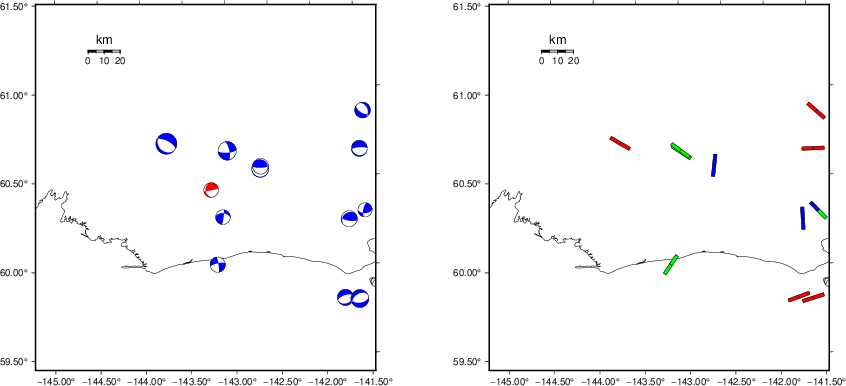Location
Location ANSS
The ANSS event ID is ak0257hxg7sg and the event page is at
https://earthquake.usgs.gov/earthquakes/eventpage/ak0257hxg7sg/executive.
2025/06/12 21:58:52 60.451 -143.224 17.9 3.3 Alaska
Focal Mechanism
USGS/SLU Moment Tensor Solution
ENS 2025/06/12 21:58:52.0 60.45 -143.22 17.9 3.3 Alaska
Stations used:
AK.BAL AK.BARN AK.BGLC AK.BMR AK.CYK AK.DIV AK.DOT AK.GHO
AK.GLB AK.GOAT AK.GRIN AK.HARP AK.HDA AK.J25K AK.KIAG
AK.KLU AK.KNK AK.L22K AK.LOGN AK.M26K AK.MCAR AK.MCK
AK.MESA AK.PS08 AK.PS11 AK.PS12 AK.PTPK AK.RAG AK.RIDG
AK.RKAV AK.SAW AK.SCM AK.SKN AK.SLK AK.TGL AK.VRDI AT.PMR
AV.N25K AV.WACK AV.WAZA CN.BRWY CN.DAWY EO.KLRS
Filtering commands used:
cut o DIST/3.3 -40 o DIST/3.3 +50
rtr
taper w 0.1
hp c 0.03 n 3
lp c 0.10 n 3
br c 0.12 0.25 n 4 p 2
Best Fitting Double Couple
Mo = 3.76e+21 dyne-cm
Mw = 3.65
Z = 19 km
Plane Strike Dip Rake
NP1 80 88 115
NP2 175 25 5
Principal Axes:
Axis Value Plunge Azimuth
T 3.76e+21 42 14
N 0.00e+00 25 259
P -3.76e+21 38 148
Moment Tensor: (dyne-cm)
Component Value
Mxx 2.73e+20
Mxy 1.54e+21
Mxz 3.36e+21
Myy -5.24e+20
Myz -5.05e+20
Mzz 2.51e+20
--############
---###################
----########################
----############ ###########
----############## T #############
----############### ##############
-----#################################
-----###################################
-----###################################
-----##################################---
-----########################-------------
-----##############-----------------------
-----#------------------------------------
#####-----------------------------------
#####-----------------------------------
#####------------------- -----------
#####------------------ P ----------
#####----------------- ---------
#####-------------------------
#####-----------------------
#####-----------------
####----------
Global CMT Convention Moment Tensor:
R T P
2.51e+20 3.36e+21 5.05e+20
3.36e+21 2.73e+20 -1.54e+21
5.05e+20 -1.54e+21 -5.24e+20
Details of the solution is found at
http://www.eas.slu.edu/eqc/eqc_mt/MECH.NA/20250612215852/index.html
|
Preferred Solution
The preferred solution from an analysis of the surface-wave spectral amplitude radiation pattern, waveform inversion or first motion observations is
STK = 175
DIP = 25
RAKE = 5
MW = 3.65
HS = 19.0
The NDK file is 20250612215852.ndk
The waveform inversion is preferred.
Magnitudes
Given the availability of digital waveforms for determination of the moment tensor, this section documents the added processing leading to mLg, if appropriate to the region, and ML by application of the respective IASPEI formulae. As a research study, the linear distance term of the IASPEI formula
for ML is adjusted to remove a linear distance trend in residuals to give a regionally defined ML. The defined ML uses horizontal component recordings, but the same procedure is applied to the vertical components since there may be some interest in vertical component ground motions. Residual plots versus distance may indicate interesting features of ground motion scaling in some distance ranges. A residual plot of the regionalized magnitude is given as a function of distance and azimuth, since data sets may transcend different wave propagation provinces.
ML Magnitude

Left: ML computed using the IASPEI formula for Horizontal components. Center: ML residuals computed using a modified IASPEI formula that accounts for path specific attenuation; the values used for the trimmed mean are indicated. The ML relation used for each figure is given at the bottom of each plot.
Right: Residuals from new relation as a function of distance and azimuth.

Left: ML computed using the IASPEI formula for Vertical components (research). Center: ML residuals computed using a modified IASPEI formula that accounts for path specific attenuation; the values used for the trimmed mean are indicated. The ML relation used for each figure is given at the bottom of each plot.
Right: Residuals from new relation as a function of distance and azimuth.
Context
The left panel of the next figure presents the focal mechanism for this earthquake (red) in the context of other nearby events (blue) in the SLU Moment Tensor Catalog. The right panel shows the inferred direction of maximum compressive stress and the type of faulting (green is strike-slip, red is normal, blue is thrust; oblique is shown by a combination of colors). Thus context plot is useful for assessing the appropriateness of the moment tensor of this event.
Waveform Inversion using wvfgrd96
The focal mechanism was determined using broadband seismic waveforms. The location of the event (star) and the
stations used for (red) the waveform inversion are shown in the next figure.
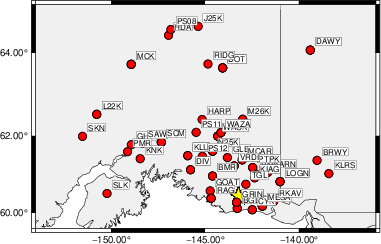
|
|
Location of broadband stations used for waveform inversion
|
The program wvfgrd96 was used with good traces observed at short distance to determine the focal mechanism, depth and seismic moment. This technique requires a high quality signal and well determined velocity model for the Green's functions. To the extent that these are the quality data, this type of mechanism should be preferred over the radiation pattern technique which requires the separate step of defining the pressure and tension quadrants and the correct strike.
The observed and predicted traces are filtered using the following gsac commands:
cut o DIST/3.3 -40 o DIST/3.3 +50
rtr
taper w 0.1
hp c 0.03 n 3
lp c 0.10 n 3
br c 0.12 0.25 n 4 p 2
The results of this grid search are as follow:
DEPTH STK DIP RAKE MW FIT
WVFGRD96 1.0 150 85 0 3.27 0.2697
WVFGRD96 2.0 90 40 90 3.42 0.3954
WVFGRD96 3.0 150 80 0 3.44 0.3552
WVFGRD96 4.0 150 55 0 3.48 0.3510
WVFGRD96 5.0 175 20 5 3.51 0.4549
WVFGRD96 6.0 175 20 5 3.52 0.5306
WVFGRD96 7.0 175 20 5 3.51 0.5710
WVFGRD96 8.0 180 15 10 3.58 0.5900
WVFGRD96 9.0 175 20 5 3.58 0.6095
WVFGRD96 10.0 175 20 5 3.57 0.6243
WVFGRD96 11.0 175 25 5 3.58 0.6360
WVFGRD96 12.0 175 25 5 3.58 0.6465
WVFGRD96 13.0 175 25 5 3.59 0.6548
WVFGRD96 14.0 175 25 5 3.59 0.6623
WVFGRD96 15.0 175 25 5 3.60 0.6687
WVFGRD96 16.0 175 25 5 3.61 0.6732
WVFGRD96 17.0 175 25 5 3.63 0.6775
WVFGRD96 18.0 175 25 5 3.64 0.6796
WVFGRD96 19.0 175 25 5 3.65 0.6817
WVFGRD96 20.0 175 25 5 3.66 0.6812
WVFGRD96 21.0 175 25 5 3.68 0.6799
WVFGRD96 22.0 180 25 10 3.70 0.6774
WVFGRD96 23.0 180 20 5 3.70 0.6735
WVFGRD96 24.0 185 20 10 3.72 0.6682
WVFGRD96 25.0 185 20 10 3.73 0.6615
WVFGRD96 26.0 190 20 15 3.74 0.6532
WVFGRD96 27.0 190 20 15 3.75 0.6432
WVFGRD96 28.0 195 20 20 3.76 0.6306
WVFGRD96 29.0 200 20 25 3.77 0.6169
The best solution is
WVFGRD96 19.0 175 25 5 3.65 0.6817
The mechanism corresponding to the best fit is
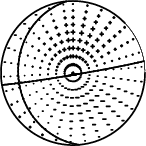
|
|
Figure 1. Waveform inversion focal mechanism
|
The best fit as a function of depth is given in the following figure:
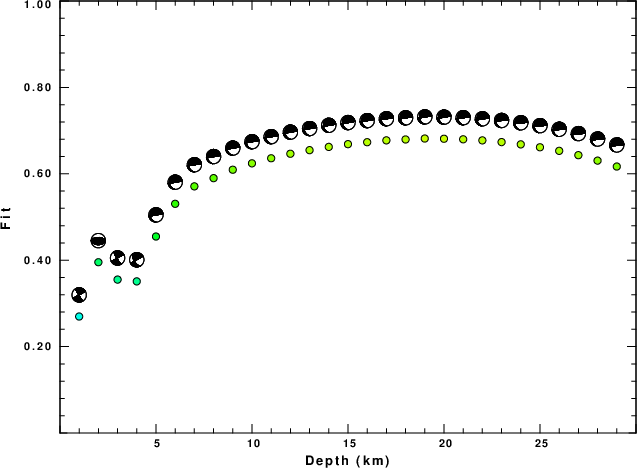
|
|
Figure 2. Depth sensitivity for waveform mechanism
|
The comparison of the observed and predicted waveforms is given in the next figure. The red traces are the observed and the blue are the predicted.
Each observed-predicted component is plotted to the same scale and peak amplitudes are indicated by the numbers to the left of each trace. A pair of numbers is given in black at the right of each predicted traces. The upper number it the time shift required for maximum correlation between the observed and predicted traces. This time shift is required because the synthetics are not computed at exactly the same distance as the observed, the velocity model used in the predictions may not be perfect and the epicentral parameters may be be off.
A positive time shift indicates that the prediction is too fast and should be delayed to match the observed trace (shift to the right in this figure). A negative value indicates that the prediction is too slow. The lower number gives the percentage of variance reduction to characterize the individual goodness of fit (100% indicates a perfect fit).
The bandpass filter used in the processing and for the display was
cut o DIST/3.3 -40 o DIST/3.3 +50
rtr
taper w 0.1
hp c 0.03 n 3
lp c 0.10 n 3
br c 0.12 0.25 n 4 p 2

|
|
Figure 3. Waveform comparison for selected depth. Red: observed; Blue - predicted. The time shift with respect to the model prediction is indicated. The percent of fit is also indicated. The time scale is relative to the first trace sample.
|
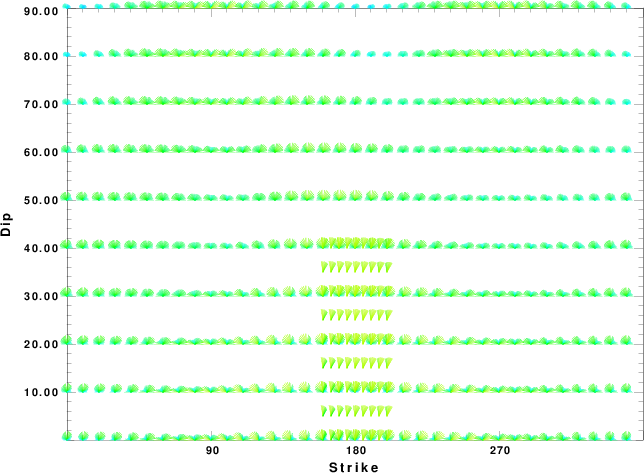
|
|
Focal mechanism sensitivity at the preferred depth. The red color indicates a very good fit to the waveforms.
Each solution is plotted as a vector at a given value of strike and dip with the angle of the vector representing the rake angle, measured, with respect to the upward vertical (N) in the figure.
|
A check on the assumed source location is possible by looking at the time shifts between the observed and predicted traces. The time shifts for waveform matching arise for several reasons:
- The origin time and epicentral distance are incorrect
- The velocity model used for the inversion is incorrect
- The velocity model used to define the P-arrival time is not the
same as the velocity model used for the waveform inversion
(assuming that the initial trace alignment is based on the
P arrival time)
Assuming only a mislocation, the time shifts are fit to a functional form:
Time_shift = A + B cos Azimuth + C Sin Azimuth
The time shifts for this inversion lead to the next figure:
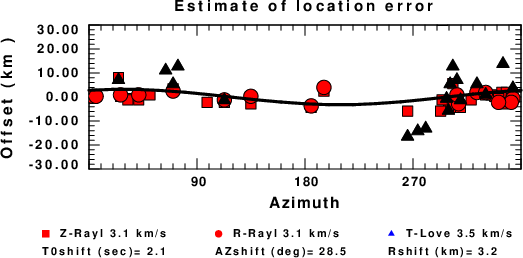
The derived shift in origin time and epicentral coordinates are given at the bottom of the figure.
Velocity Model
The WUS.model used for the waveform synthetic seismograms and for the surface wave eigenfunctions and dispersion is as follows
(The format is in the model96 format of Computer Programs in Seismology).
MODEL.01
Model after 8 iterations
ISOTROPIC
KGS
FLAT EARTH
1-D
CONSTANT VELOCITY
LINE08
LINE09
LINE10
LINE11
H(KM) VP(KM/S) VS(KM/S) RHO(GM/CC) QP QS ETAP ETAS FREFP FREFS
1.9000 3.4065 2.0089 2.2150 0.302E-02 0.679E-02 0.00 0.00 1.00 1.00
6.1000 5.5445 3.2953 2.6089 0.349E-02 0.784E-02 0.00 0.00 1.00 1.00
13.0000 6.2708 3.7396 2.7812 0.212E-02 0.476E-02 0.00 0.00 1.00 1.00
19.0000 6.4075 3.7680 2.8223 0.111E-02 0.249E-02 0.00 0.00 1.00 1.00
0.0000 7.9000 4.6200 3.2760 0.164E-10 0.370E-10 0.00 0.00 1.00 1.00
Last Changed Fri Jun 13 07:55:16 EDT 2025


